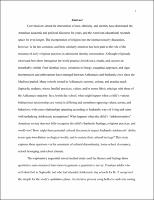Please use this identifier to cite or link to this item:
https://hdl.handle.net/20.500.12202/8902| Title: | A minority within a minority: Sephardic adolescents in Ashkenazic schools |
| Authors: | Pelcovitz, David Novick, Rona Krakowski, Moshe Rand, Elana Riback |
| Keywords: | Education Multicultural education Religious education Ashkenormativity cultural discontinuity home-school dissonance mixed methods school belonging |
| Issue Date: | May-2023 |
| Publisher: | Yeshiva University |
| Citation: | Rand, E. R. (2023, May). A minority within a minority: Sephardic adolescents in Ashkenazic schools (Publication No. 30487044) [Doctoral dissertation, Yeshiva University]. PDTG |
| Series/Report no.: | Azrieli Doctoral Dissertations;Publication No. 30487044 |
| Abstract: | Conversations about the intersection of race, ethnicity, and identity have dominated the American academic and political discourse for years, and the American educational research space for even longer. The incorporation of religion into the intersectionality discussion, however, is far less common; and little scholarly attention has been paid to the role of the minutiae of daily religious practices in adolescent identity construction. Although religiously observant Jews from throughout the world practice Jewish laws, rituals, and customs in remarkably similar if not identical ways, variations in liturgy, exegetical approach, and legal interpretation and enforcement have emerged between Ashkenazic and Sephardic Jews since the Medieval period. Many schools rooted in Ashkenazic customs, culture, and practice teach Sephardic students, whose familial practices, values, and/or norms likely misalign with those of the Ashkenazic majority. In a Jewish day school, what might happen when a child’s various bidirectional relationships are rooted in differing and sometimes opposing values, norms, and behaviors, with some relationships operating according to Sephardic ways of living and some with underlying Ashkenazic assumptions? What happens when the child’s “Ashkenormative” American society does not fully recognize the child’s Sephardic heritage, religious practices, and worldview? How might these potential cultural disconnects impact Sephardic adolescents’ ability to navigate two distinct ecological worlds, and to sustain their cultural heritage? This study explores these questions via the constructs of cultural discontinuity, home-school dissonance, school belonging, and school climate.¶ This exploratory sequential mixed method study used the themes and findings from qualitative semi-structured interviews to generate a quantitative survey. Fourteen adults who self-identified as Sephardic and who had attended Ashkenazic day schools for K-12 comprised the sample for the study’s qualitative phase. An iterative process using both etic and emic coding strategies revealed prevalent themes in the interviewees’ recalled experiences of K-12, including the impact of curriculum, prayer, attitudes about religious difference, and relationships with peers and teachers. Findings highlighted the particular religious behavioral discontinuities necessary for inclusion in the survey, as well as the importance of incorporating questions about school climate and immigration. ¶ Modern Orthodox middle schools with policies and programs rooted in Ashkenazic customs and with substantial Sephardic student representation were solicited for inclusion in the quantitative phase of the study. Surveys were administered to seventh and eighth-grade students (N=378) in four schools. Data analysis to address the quantitative components of the research questions involved the use of independent samples t-tests, Pearson product-moment correlations, and multiple hierarchical regression models. Findings strongly indicated that Sephardic students experienced greater levels of discontinuity and home-school dissonance, and lower levels of belonging, than their Ashkenazic peers. Significant associations between cultural discontinuity items, home-school dissonance, and school belonging emerged for Ashkenazic students, but almost no significant associations emerged for Sephardic students. Beta-values from the moderation models indicated that teacher support, peer attachment, affirming diversity, and home-school dissonance each independently predicted school belonging, but that the relationship between home-school dissonance and school belonging was not significantly impacted by the school climate domains of teacher support, peer attachment, and affirming diversity. ¶ The findings suggest that while Sephardic students do emotionally link their experiences as members of the school community with the degree to which they feel that their home and school ecological environments do or do not align, they do not pair dissonance with the specific items measured in the cultural discontinuity scale. Significant correlations between discontinuity items and climate data suggest that norms of religious practice do relate to students’ perceived school climate; interview data further demonstrate how the pedagogical methods, curricular selections, and interpersonal choices of teachers and other school personnel can be unconsciously interpreted and internalized by students as indications of teachers’ values and assumptions.¶ This study demonstrates the relevance of applying discontinuity, dissonance, and belonging constructs to the study of American youth from minority populations whose identities extend beyond contemporary social understandings of race. Even further, the findings explore experiences, not just of a minority within a majority, but of various minority subgroups within a larger minority. Rather than implementing policies to sustain specific cultural behaviors, school educators may be better served by working on school climate and school culture initiatives that emphasize inclusivity and celebrate differences, in whatever forms they take. |
| Description: | Doctoral dissertation, PhD / Open Access |
| URI: | https://hdl.handle.net/20.500.12202/8902 https://ezproxy.yu.edu/login?url=https://www.proquest.com/dissertations-theses/minority-within-sephardic-adolescents-ashkenazic/docview/2811494325/se-2?accountid=15178 |
| ISBN: | 9798379503857 |
| Appears in Collections: | Azrieli Graduate School of Jewish Education & Administration: Doctoral Dissertations |
Files in This Item:
| File | Description | Size | Format | |
|---|---|---|---|---|
| Rand A Minority OA_may 2023.pdf | 1.15 MB | Adobe PDF |  View/Open |
This item is licensed under a Creative Commons License

